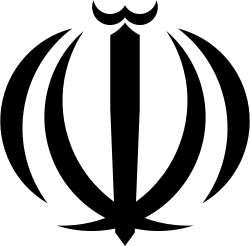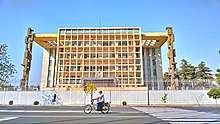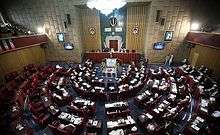Assembly of Experts
The Assembly of Experts (Persian: مجلس خبرگان رهبری, romanized: majles-e khobregân-e rahbari) —also translated as the Assembly of Experts of the Leadership or as the Council of Experts— is the deliberative body empowered to appoint and dismiss the Supreme Leader of Iran.[2][3] All directly-elected members must first be vetted by the Guardian Council and approved by the Supreme Leader before gaining membership.[4][5]
Assembly of Experts | |
|---|---|
 | |
| Leadership | |
Chairman | Ahmad Jannati since 24 May 2016 |
First Deputy Chairman | Ebrahim Raisi since 12 March 2019 |
Second Deputy Chairman | Ali Movahedi-Kermani since 13 March 2018 |
| Structure | |
| Seats | 88 (6 vacant) |
Political groups | Combatant Clergy Association Society of Seminary Teachers of Qom People's Experts |
Length of term | 8 years[1] |
| Elections | |
| Multi-seat districts: Plurality-at-large voting Single-seat districts: First-past-the-post voting[1] | |
Last election | 26 February 2016 |
| Meeting place | |
 | |
| Assembly of Experts building, Tehran, Iran | |
| Website | |
| http://www.majlesekhobregan.ir/ | |
 |
|---|
| This article is part of a series on the politics and government of Iran |
| Government of Islamic Republic of Iran |
|
Leadership |
|
Executive |
|
|
Supreme Councils |
|
Local governments
|
|
|
|
|
Outside government |
|
All candidates to the Assembly of Experts must be approved by the Guardian Council whose members are, in turn, appointed either directly or indirectly by the Supreme Leader.[6] The Assembly consists of 88 Mujtahids that are elected (after approval by the Supreme Leader)[4][5] from lists of thoroughly vetted candidates by direct public vote for eight-year terms.[7] The number of members has ranged from 82 elected in 1982 to 88 elected in 2016. Current laws require the assembly to meet at least twice every six months.[8][9]
Functions
The Assembly is by its nature judicial rather than theological. According to the Iranian Constitution, the assembly is in charge of supervising, dismissing and electing the Supreme Leader. In the event of his death, resignation or dismissal, the Experts take steps within the shortest possible time to appoint a new Leader.[10] The Constitution states that if the Leader "becomes incapable of fulfilling his constitutional duties, or loses one of the qualifications mentioned in the Constitution, or it becomes known that he did not possess some of the qualifications initially, he will be dismissed."[10] The assembly has never dismissed a sitting Supreme Leader, and as all of their meetings and notes are strictly confidential. The assembly has never been known to challenge or otherwise publicly oversee any of the Supreme Leader's decisions.[11]
To choose the Supreme Leader, the Experts review qualified candidates and consult among themselves. According to the Constitution, the criteria of qualification for the office of the Supreme Leader include "Islamic scholarship, justice, piety, right political and social perspicacity, prudence, courage, administrative facilities and adequate capability for leadership."[10] The jurist deemed as the most well-versed in Islamic regulations, in fiqh, or in political and social issues, most generally popular, or of other special prominence is chosen as Supreme Leader. Otherwise, in the absence of such a candidate, the Experts elect and declare one of their own as Supreme Leader.[10]
The 1989 Iranian constitutional referendum removed the requirement for the leader to be a marja'. Ali Khamenei was not a marja' at that time.
The assembly gathers every six months. Activities of the assembly include compiling a list of those eligible to become Supreme Leader in the event of the current Supreme Leader's death, resignation, or dismissal. This is done by the 107/109 commission.[12] Monitoring the current leader to make sure he continues to meet all the criteria listed in the constitution is done by the 111 commission.[12] Members of the Assembly report to this commission about the issues concerning the current Supreme Leader, and the commission can then order an emergency meeting of the Assembly. If the commission denies this, the members can ask the entire plenary of the Assembly (86 members) for a vote, and if most of the members vote in favor, an emergency meeting will be scheduled to discuss the current Supreme Leader. The meetings, meeting notes, and reports of the Assembly are confidential and not made available to anyone outside the assembly, except for the sitting Supreme Leader.[12]
The constitution does not specify requirements for candidacy for the Assembly of Experts, leaving the Assembly itself to put limits on who may run for membership. The assembly has passed laws to require all its members be experts in fiqh (Islamic jurisprudence),[13] authorizing the Guardian Council to vet candidates for ijtihad proficiency using written and oral examinations. This law was challenged by the reformists, and their 2006 election campaign included changing this law to allow non-clerics into the assembly, and reforming the law that allows Guardian Council to vet candidates.[14][15] Women (Mujtahidehs) are theoretically eligible to run for the Assembly of Experts and in 1998 nine women submitted their candidacy. The Guardian Council rejected them, arguing that they lacked qualifications in fiqh.
Currently, the average age of the members of the Assembly is over 60 years, which results in many mid-term elections due to deaths and resignations. The members must be Ayatollahs.[16]
Assemblies
First Assembly (1983–1991)
The first elections for the Assembly of Experts of the Leadership were held in December 1982 and the Assembly first convened in 1983. 76 of the total of 83 members were elected in the first round, the rest in the second. The full list of members and election results is available on the Princeton Iran Data Portal.[17]
As a number of members died, by-elections for replacement candidates were held in April 1988.
The Assembly was chaired throughout the term by Ayatollah Ali Meshkini, who chaired the Assembly also in subsequent terms until 2007.
In 1985, the Assembly chose Ayatollah Montazeri as the successor to Supreme Leader Grand Ayatollah Khomeini. But on Sunday, 26 March 1989 Khomeini dismissed him in a letter: "... you are no longer eligible to succeed me as the legitimate leader of the state."[18] Following the death of Ruhollah Khomeini on 3 June 1989, the Assembly of Experts chose Ali Khamenei to be his successor as Supreme Leader in what proved to be a smooth transition.[19] Initially, a council of three members, "Ali Meshkini, Mousavi Ardabili and Ali Khamenei", were proposed for Leadership. After rejection of a Leadership Council by the assembly, and lack of votes for Grand Ayatollah Mohammad Reza Golpaygani, Khamenei became the Supreme Leader by two third of the votes.[20][21]
Second Assembly (1991–1999)
The Second Assembly was also chaired by Ayatollah Ali Meshkini. The full list of members and election results is available on the Princeton Iran Data Portal.[22] Sayed Mohammad Fagheh was one of the members from the province Neyriz Fars.
Third Assembly (1999–2007)
The 3rd assembly was again chaired by Ayatollah Ali Meshkini, deputied by Ali Akbar Hashemi Rafsanjani, and Ayatollah Ebrahim Amini. The scribes were former Minister of Intelligence Ghorbanali Dorri-Najafabadi and Ahmad Khatami. The members according to each province were:[23][24]
|
|
|
Fourth Assembly (2007–2016)

The election for the fourth assembly took place on 15 December 2006 and the Assembly first convened on 19 February 2007. In July 2007, chairman Ayatollah Meshkini died, and Ayatollah Rafsanjani was elected to succeed him. On 8 March 2011, Ayatollah Mohammad-Reza Mahdavi Kani replaced Ayatollah Rafsanjani as chairman.[16] On 4 June 2014, Mahdavi Kani fell into a coma after suffering a heart attack and died on 21 October 2014. He was succeeded by Mahmoud Hashemi Shahroudi as acting chairman.[25]
The term was intended to last for ten years, rather than the usual eight, due to the "election aggregation" plan of the government put in place to allow the government to run elections simultaneously for the Assembly of Experts and the Parliament, thereby economizing election administration costs.
Fifth Assembly (2016–present)
The election of 88 members of the Fifth Assembly took place on 26 February 2016 alongside of the election for 290 members of the Iranian Majlis (parliament). Those elected will sit for a projected 8-year term.[26] The new assembly was opened on 24 May 2016 and selected Ahmad Jannati as chairman of the Fifth Assembly.[27]
Authority
The Assembly has never questioned the Supreme Leader.[28] Due to Ali Khamenei's lengthy, unchallenged reign, many believe that the Assembly of Experts has become a ceremonial body without any real power.[29][30][31][32] Iran's Chief Justice Sadeq Larijani, a Khamenei appointee, stated that it is illegal for the Assembly of Experts to supervise Khamenei.[33]
There have been instances when the current Supreme Leader's public criticism of members of the Assembly of Experts was followed by their arrest and dismissal. For example, Khamenei publicly called member of the Assembly of Experts Ahmad Azari Qomi a traitor, resulting in Qomi's arrest and eventual dismissal from the Assembly of Experts. Another instance is when Khamenei indirectly called the late Akbar Hashemi Rafsanjani a traitor for a statement he made causing Rafsanjani to retract it.[34] Mehdi Karroubi, who has been under house arrest since 2011 without trial, by the direct order of Khamenei, said that "the Assembly of Experts, a council of elected clerics charged with electing, supervising and even disqualifying the Supreme Leader, has turned into a ceremonial council that only praises the Leader.”[35][36][37]
References
- Nohlen, Dieter; Grotz, Florian; Hartmann, Christof (2001). "Iran". Elections in Asia: A Data Handbook. I. Oxford University Press. p. 64. ISBN 0-19-924958-X.
- Article 107 of the Constitution of Iran}}
- Article 111 of the Constitution of Iran
- (see Article 108 of the constitution)
- LL.M., Prof. Dr. Axel Tschentscher. "ICL - Iran - Constitution". www.servat.unibe.ch. Retrieved 6 April 2018.
- "Rafsanjani breaks taboo over selection of Iran's next supreme leader". the Guardian. 14 December 2015.
- "Understanding Iran's Assembly of Experts" (PDF). Archived from the original (PDF) on 30 June 2007. Retrieved 28 July 2012.
- Archived 9 March 2007 at the Wayback Machine
- Robin Wright, The Last Great Revolution: Turmoil and Transformation in Iran, Alfred A. Knopf, 2000
- "Iranian Government Constitution, English Text". Iran Online. Archived from the original on 23 November 2010. Retrieved 28 July 2012.
- "Iran Announces Second Extension of Voting," Reuters, 23 October 1998.
- Discussion and assembly website Archived 7 October 2007 at the Wayback Machine
- Archived 28 September 2007 at the Wayback Machine
- "آفتاب – شورای مشورتی اصلاح طلبان برای شوراها". Aftab News. Archived from the original on 5 February 2012. Retrieved 1 June 2012.
- موسوی لاری و تشريح برنامه های مجمع روحانيون در خبرگان Archived 20 February 2009 at the Wayback Machine
- Khalaji, Mehdi (February 2012). "Supreme Succession. Who Will Lead Post-Khamenei Iran?" (PDF). The Washington Institute. Washington DC. Archived from the original (Policy Focus (No. 117)) on 16 April 2014.
- "Iran Data Portal". Princeton.edu. Retrieved 26 February 2017.
- Archived 6 March 2007 at the Wayback Machine
- "Background Note: Iran". State.gov. 1 February 2012. Retrieved 1 June 2012.
- "خبرگان رهبری – رييس مجمع تشخيص مصلحت نظام: از مهمترين پيشرف". Khobreganrahbari.com. Archived from the original on 6 February 2012. Retrieved 28 July 2012.
- "Archived copy". Archived from the original on 15 June 2007. Retrieved 2013-12-19.CS1 maint: archived copy as title (link)
- "Iran Data Portal". Princeton.edu. Retrieved 26 February 2017.
- Manou & Associates Inc. "Islamic Republic of Iran Members of Assembly of Experts". Iran online. Archived from the original on 21 February 2010. Retrieved 1 June 2012.
- "Iran Data Portal". Princeton.edu. Retrieved 26 February 2017.
- "Head of Iran's top clerical body dies - Al-Monitor: the Pulse of the Middle East". Al-Monitor.
- "Iran election extended amid high turnout". BBC. British Broadcasting Corporation. 26 February 2016. Retrieved 26 February 2016.
- "Hard-line cleric becomes speaker of Assembly of Expert". Associated Press. 24 May 2016. Retrieved 24 May 2016.
- Emma Borden (9 February 2016). "Everything you need to know about Iran's Assembly of Experts election". The Brookings Institution.
- "Myths and Realities of Iran's Parliamentary Elections". The Atlantic. 23 February 2016. Retrieved 26 February 2017.
- "Anomalies in Iran's Assembly of Experts Election - The Washington Institute for Near East Policy". Washingtoninstitute.org. 22 March 2016. Retrieved 26 February 2017.
- "The Islamic Republic Before and After the 2009 Elections". Payvand.com. Retrieved 26 February 2017.
- "Archived copy". Archived from the original on 4 February 2017. Retrieved 3 June 2017.CS1 maint: archived copy as title (link)
- Al-awsat, Asharq (15 December 2015). "Controversy in Iran Surrounding the Supervision of the Supreme Leader's Performance - ASHARQ AL-AWSAT". Archived from the original on 25 June 2016. Retrieved 1 July 2016.
- Arash Karami (31 March 2016). "Rafsanjani missile tweet draws fire from Khamenei". Al-monitor.com. Retrieved 26 February 2017.
- Sharafedin, Bozorgmehr (30 January 2018). "Iranian opposition cleric accuses Khamenei of abuse of power". Reuters. Retrieved 6 April 2018.
- "Iranian cleric delivers rare public criticism of Ayatollah Khamenei - CBC News". cbc.ca. Retrieved 6 April 2018.
- Iranian Opposition Cleric Accuses Khamenei of Abuse of Power usnews.com
External links
| Wikimedia Commons has media related to Assembly of Experts of the Leadership. |
- Official website
- Princeton Iran Data Portal: List of Election Results for all years, including breakdown by province
- Assembly of Experts in the Constitution of Islamic Republic of Iran
- Understanding Iran's Assembly of Experts from Durham University
- Results of Assembly of Experts elections in 6 provinces
- Results of Assembly of Experts elections in four provinces
- Results of Assembly of Experts elections in some provinces
- Iran Electoral Archive – Assembly of Experts